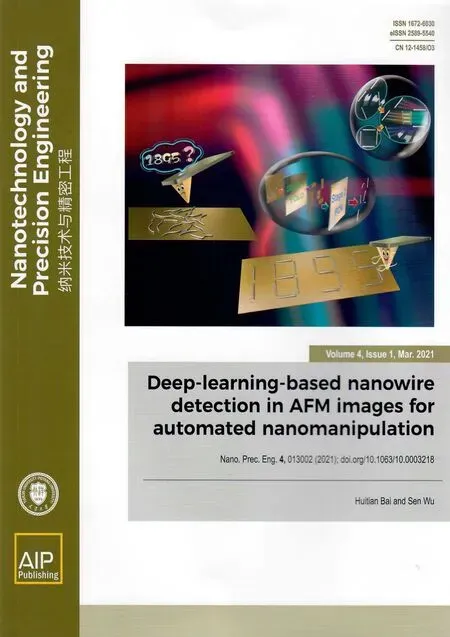Propagation characteristics of photonic crystal fibers selectively filled with ionic liquid
Xiaoqi Liu, Yange Liu,and Zhi Wang
ABSTRACT We present a numerical and experimental study of the propagation characteristics of photonic crystal fibers (PCFs) selectively filled with ionic liquid(IL;1-butyl-3-methylimidazolium iodine).Three types of IL-filled PCF are investigated:one with all air holes filled,one with an IL-filled air hole in the second ring,and one with an IL-filled air hole in the third ring.The results show that the third type of IL-filled PCF is the most sensitive to temperature;the sensitivity of resonant dips between the LP01 and LP21 modes is ~?2.9 nm/○C.Moreover,the intensity of the resonant dips changes with the polarization angle of the light source;the sensitivity is ~?0.79 dB per unit polarization angle.Based on this property,IL-filled PCFs with different utilities can be realized by changing the filling position flexibly.Consequently,IL-filled PCFs can be used under flexible conditions and controllable temperatures to create a compact polarization-angle sensor.
? 2021 Author(s). All article content, except where otherwise noted, is licensed under a Creative Commons Attribution (CC BY) license(http://creativecommons.org/licenses/by/4.0/). https://doi.org/10.1063/10.0002950
KEYWORDS Photonic crystal fiber, Ionic liquid, Optical sensor, Polarization
I. INTRODUCTION
Photonic crystal fibers (PCFs) have good-quality microfluidic channels throughout their length, being able to hold a sample volume of a few nanoliters per centimeter of fiber.1With the help of selective filling technology,selectively filled PCFs have attracted considerable interest in optical-fiber device fabrication, and they offer a number of potential applications in environmental monitoring,biological detection,and sensing,among others.2,3
Ionic liquids (ILs), which have been known about for a century,have received extensive interest only recently because of their unique characteristics.4ILs are used widely nowadays as solvents and reaction media in many diverse applications such as carbon dioxide sensors,5electrospinning,6catalysis,7,8energy storage,9and nanostructure synthesis.10,11
In this paper,we investigate three types of PCF selectively filled with IL(1-butyl-3-methylimidazolium iodine):one with all air holes filled, one with an IL-filled air hole in the second ring, and one with an IL-filled air hole in the third ring. The transmission properties of these selectively filled PCFs are analyzed numerically and experimentally.
II. EXPERIMENTAL DETAILS
The PCFs(L=8.0 cm)used in our experiment were fabricated by Yangtze Optical Fiber and Cable Company Ltd., China. Each PCF has five rings of air holes running along its axis, as shown in Fig. 1(a). The average diameter of the air holes is 3.9μm,and the average interhole spacing is 5.75μm. The IL used was 1-butyl-3-methylimidazolium iodine, produced by Shanghai Chengjie Chemical Co.,Ltd.,China,and the refractive index is 1.572 at 532 nm. The cross sections of the three types of IL-filled PCF are shown in Figs.1(b)-1(d),respectively.In the first PCF type,IL infiltrated all the air holes under capillary force[Fig.1(b)],whereas the second and third PCF types were developed by infiltrating IL selectively into one air hole in the second and third ring,respectively[Figs. 1(c) and 1(d)]. The filled hole can be considered as being a liquid waveguide.
The experimental setup used to measure the rates of change of the spectra of the first and second types of IL-filled PCF is shown in Fig. 2(a). The range of the broadband light source (BLS; Keysight 8164B lightwave measurement system) was 600-1700 nm. The IL-filled PCFs were placed in a temperature chamber, and an optical spectrum analyzer (OSA; Yokogawa AQ6370C; operation wavelength range: 600-1700 nm) with a maximum resolution of 0.02 nm was used for analysis.

FIG.1.(a)Cross section of original photonic crystal fiber(PCF).Cross sections of ionic liquid(IL)-filled PCFs:(b)fully filled;(c)air hole filled in second ring;(d)air hole filled in third ring.
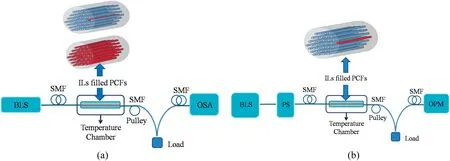
FIG.2.Schematics of experimental setups used to measure(a)rates of change of spectra and(b)intensity changes of resonant dips with polarization of light source.BLS,broadband light source;SMF,single-mode fiber;OSA,optical spectrum analyzer;PS,polarization synthesizer;OPM,optical power meter.
Figure 2(b) shows the experimental setup used measure how the intensity of the resonant dips changed with the polarization of the light source. The range of the BLS was 1455-1640 nm, and a polarization synthesizer (PS; Keysight N7786B) was used. The third type of IL-filled PCF was placed in the temperature chamber, whereupon an optical power meter (OPM; Keysight N7744A; operation wavelength range: 1455-1640 nm) with a maximum resolution of 2 pm was used.

FIG. 3. (a) Bandgap distribution of PCF fully filled with IL. The pink dasheddotted line marks the effective refractive index of silica, namely, n = 1.444, and the blue dashed line marks the effective refractive index of LP01 in the silica core. (b) Mode field of LP01 in different bandgaps.
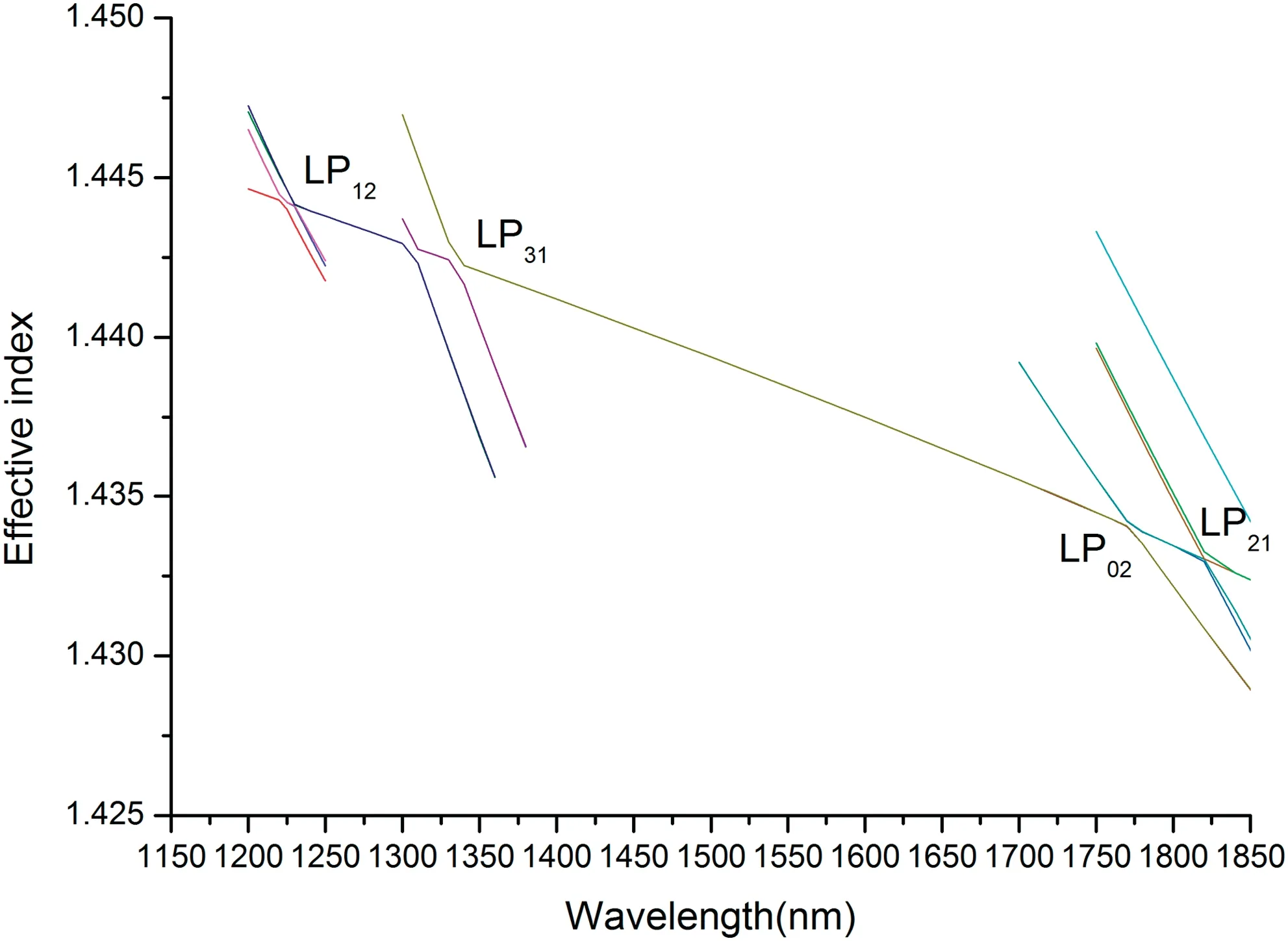
FIG.4.Dispersion characteristics of LP01 in solid core and higher-order modes in IL core in second ring of PCF.
First,we investigate numerically the characteristics of the three different types of filled PCF. All the calculations are based on the full-vector finite-element method and plane-wave expansion method.The parameter values were set to those of the actual PCFs as given above.Figure 3 shows the room-temperature bandgap distribution for the fully filled PCF shown in Fig. 1(b). The normal index-guided PCF was transformed into a photonic bandgap fiber because of the higher refractive index of the IL rods in the cladding compared with that in the air holes.There are two obvious bandgaps,namely,1100-1200 nm(bandgap 1)and 1200-1500 nm(bandgap 2),in which the fundamental mode LP01of the central solid core is confined; this is formed by the super mode of the IL-filled rods in the cladding.
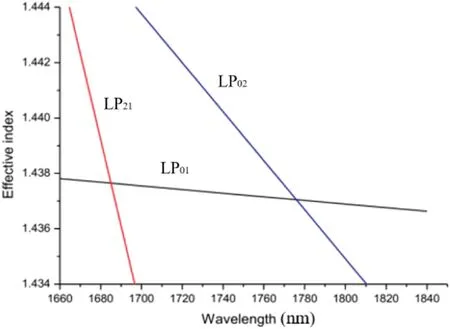
FIG.5.Dispersion characteristics of LP01 in solid core and higher-order modes in IL core in third ring of PCF.
Figure 4 shows the dispersion characteristics for LP01in the central solid core and the higher-order modes in the IL-filled core in the second ring of the PCFs. LP01couples with LP12and LP31,and the anti-cross area is around the wavelengths of 1200 and 1300 nm.Moreover,LP01couples with LP02and LP21around the longer wavelength of 1800 nm.
For the third type of PCF, the IL is in the third ring, separated from the central solid core by two rings of air holes.Therefore, we consider the solid core and the IL core as being two separate waveguides.12The dispersion characteristics for LP01and the higher-order modes are shown in Fig. 5. The resonant wavelength between LP01and LP21is around 1690 nm. LP01and LP02couple at longer wavelength, and the resonant wavelength is around 1780 nm, which is similar to that shown in Fig.4.
III. RESULTS AND DISCUSSION
In the experiment, selective filling13was used to fill each PCF with IL as shown in Figs.1(b)-1(d).In each type of filled PCF,the length filled with IL was nearly 8.0 cm, and the air holes at either end were left to reduce the splice loss when spliced with a standard single-mode fiber(SMF;Corning SMF-28).During the experiment,the filled PCFs were placed in a temperature chamber to change the effective refractive index of the IL.
Figure 6(a)shows the transmission spectrum of the fully filled PCF shown in Fig. 1(b). The insertion loss is less than 12 dB,due mainly to the mode field mismatch of splicing between the PCF and SMF. There are three clear attenuation gaps at the wavelengths of 780-830 nm(BG1),1000-1100 nm(BG2),and 1280-1500 nm (BG3). The positions of BG2 and BG3 are similar to the simulation results, as shown in Fig. 3. With increasing temperature,the entire spectrum moves to shorter wavelengths. We measured the movement of dip A; with increasing temperature from 27○C to 60○C, the sensitivity is around ?2.9 nm/○C as shown in Fig.6(b).
Figure 7 shows the propagation characteristics of the second type of PCF shown in Fig. 1(c). Unlike that in Fig. 6(a), this spectrum contains no bandgap,but Fig.7(a)shows some obvious resonant dips. According to the simulation results, the dips at around 1080 and 1260 nm should be due to the coupling between LP12and LP01and between LP31and LP01, respectively. The coupling between LP02and LP01and between LP21and LP01could not be measured because the upper measurement wavelength of the OSA was 1700 nm.
Next, we analyze the temperature tuning characteristics of this type of PCF. Figure 7(a) shows the transmission spectrum at 30○C, 39○C, and 48○C. With increasing temperature, each dip in the resonant region experienced blue shift. The shapes of the resonant dips for LP12and LP01changed minimally with temperature, which is why we measured only the resonant dips for LP31and LP01. The relationship between resonant wavelength and temperature maintains good linearity, being around ?1.89 and?1.95 nm/○C as measured from dips B1 and B2, respectively, in Fig.6(b).
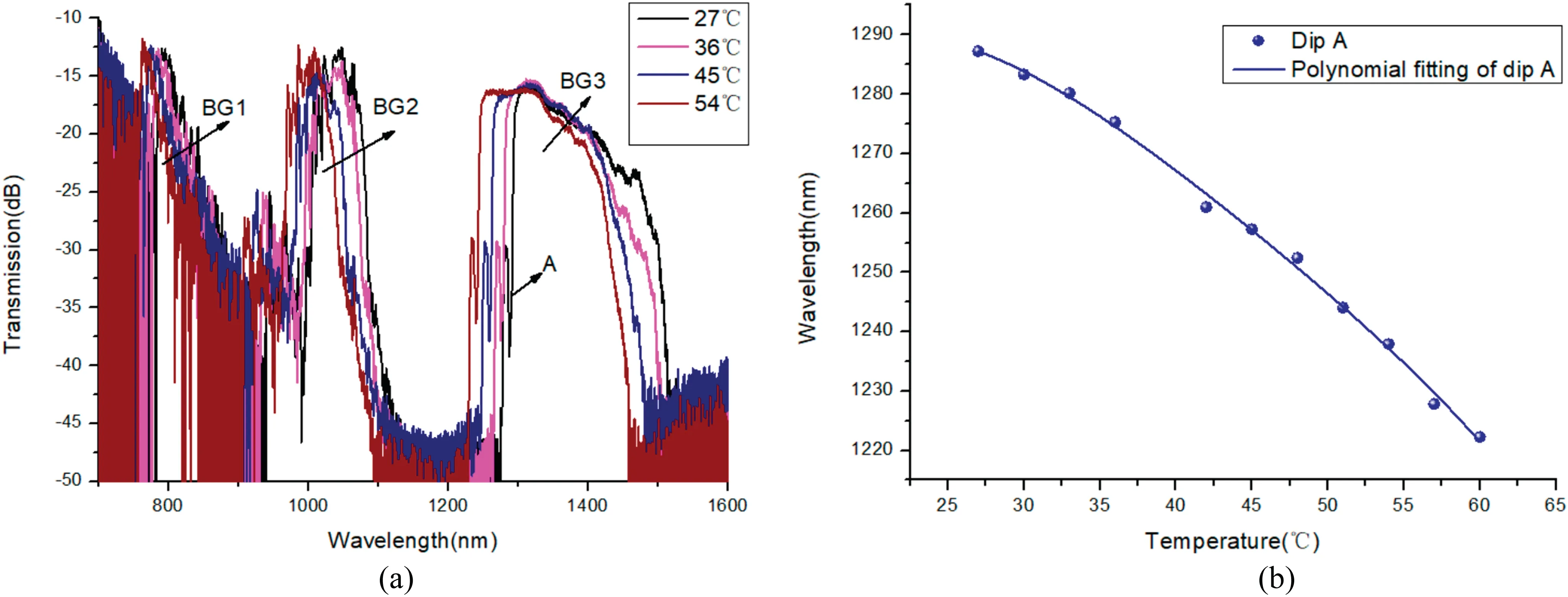
FIG.6.Propagation characteristics of PCF fully filled with IL:(a)transmission spectrum at different temperatures;(b)temperature response of dip A.
Next, we study the third type of IL-filled PCF shown in Fig. 1(d). With the setup illustrated in Fig. 2(b), the polarization angle (PA) from 0○to 90○was divided into 40 equally spaced values. Similar to the details shown in Fig. 6(a), the spectrum from 1450 to 1640 nm contains some resonant dips,as shown in Fig.8(a).These dips could be formed by the coupling between LP21and LP01in this wavelength range. Moreover, the coupling between the modes in this type of PCF is weaker because the distance between the silica core and the IL-filled core in the third ring is greater than that in the second ring, and so the resonant dips are narrower.
Figure 8(a) shows the transmission spectrum of the resonant dips under different PAs at a temperature of 37○C. The intensity of the coupling between the different modes changes with the polarization of the input light. If the polarization of the two coupling modes is similar,then the dips in the spectra deepen,and vice versa. Figure 8(b) shows that the intensity of dip C changes linearly as the PA increases from 52.5○to 62.5○and becomes shallow when the PA rises to 57.5○. The sensitivity is around?0.79 dB/PA.
Next,we analyze the temperature response of this type of PCF.The PA of the input light was set to 10○because the transmission dips of this type of PCF are sensitive to the PA.Moreover,the effective refractive index of the IL changed slightly with temperature,and the dip intensity tended to be shallow under the same PA.Therefore,the temperature was increased by only 0.1○C each time to reduce the effects of temperature and polarization on the spectrum shape,as seen in Fig.8(c).The sensitivity of dips D1 and D2 is around ?2.26 and ?3.51 nm/○C,respectively[Fig.8(d)].

FIG.8.Propagation characteristics of PCF with IL-filled air hole in third ring:(a)transmission spectrum at polarization angle(PA)of 52.5○,55.0○,and 57.5○:(b)PA response of dip C;(c)transmission spectrum at temperature of 36.6 ○C,36.7 ○C,36.8 ○C,and 36.9 ○C;(d)temperature responses of dips D1 and D2.
IV. CONCLUSIONS
We developed three types of IL-filled PCF and investigated their bandgap distribution, coupling mode, and propagation characteristics numerically and experimentally. The PCF with an ILfilled air hole in the third ring was the most sensitive to temperature, with a sensitivity of around ?2.9 nm/○C. The intensity of the resonant dip was sensitive to the PA; the rate of change of PA intensity was around ?0.79 dB/PA. The utility of IL-filled PCFs can be controlled by changing the filling position flexibly,thereby allowing IL-filled PCFs to be used under flexible conditions and controllable temperatures to create a compact PA sensor.
ACKNOWLEDGMENTS
This work was supported partly by the National Natural Science Foundation of China (Grant Nos. 11804171, 11674177, and 61775107), partly by the Natural Science Foundation of Tianjin,China (Grant No. 16JCZDJC31000), and partly by the Self-made Experiment Teaching Instrument Project of Nankai University 2018(Grant No.2018NKZZYQ04).
The authors declare that they have no known competing financial interests or personal relationships that could have appeared to influence the work reported in this paper.
- 納米技術(shù)與精密工程的其它文章
- Deep-learning-based nanowire detection in AFM images for automated nanomanipulation
- A combined virtual impactor and field-effect transistor microsystem for particulate matter separation and detection
- Design of a hexagonal air-coupled capacitive micromachined ultrasonic transducer for air parametric array
- On-site low-power sensing nodes for distributed monitoring of heavy metal ions in water
- Characteristics of Ni-based ohmic contacts on n-type 4H-SiC using different annealing methods

